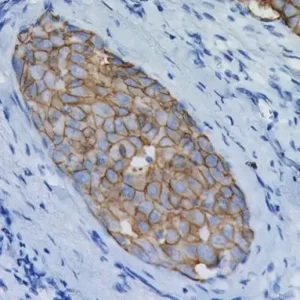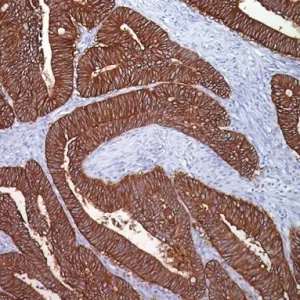Description
CD137, a member of the tumor necrosis factor receptor superfamily, represents a promising target for enhancing antitumor immune responses (1). The functions of CD137 in T lymphocytes include regulating activation, proliferation and apoptosis (2). CD137 helps regulate the activation of many immune cells, including CD4(+) T cells, CD8(+) T cells, dendritic cells, and natural killer cells. Recent studies indicate that the antitumor efficacy of therapeutic tumor-targeting antibodies can be augmented by the addition of agonistic antibodies targeting CD137. As ligation of CD137 provides a costimulatory signal in multiple immune cell subsets, CD137 antibody has potential to improve cancer treatment, and has been implicated in breast cancer, melanoma and lymphoma (3-5). Therefore, CD137 agonists represent a promising immunotherapeutic approach to treating cancers.
SPECIFICATIONS
Specifications
| FORMAT | Concentrate, Predilute |
|---|---|
| VOLUME | 0.1 ml, 0.5 ml, 6.0 ml |
| SOURCE | Mouse Monoclonal |
| BY LETTER | C |
| ANTIGEN | Ectodomain of human 4-1BB recombinant protein |
| CLONE | BBK-2 |
| INTENDED USE | IVD |
| ISOTYPE | IgG1/kappa |
| LOCALIZATION | Cell surface |
| POSITIVE CONTROL | Small intestine with Peyer’s patches, tonsil |
| SPECIES REACTIVITY | Human; others not tested |
REFERENCES
1. Yonezawa A, et al. Boosting cancer immunotherapy with anti-CD137 antibody therapy. Clin Cancer Res. 2015 Jul 15;21(14):3113-20.
2. Hurtado JC, et al. Potential role of 4-1BB in T cell activation. Comparison with the costimulatory molecule CD28. J Immunol. 1995 Oct 1;155(7):3360-7.
3. Martinet O, et al. T cell activation with systemic agonistic antibody versus local 4-1BB ligand gene delivery combined with interleukin-12 eradicate liver metastases of breast cancer. Gene Ther. 2002 Jun;9(12):786-92.
4. Li SY, Liu Y. Immunotherapy of melanoma with the immune costimulatory monoclonal antibodies targeting CD137. Clin Pharmacol. 2013 Sep 2;5(Suppl 1):47-53.
5. Zhao S, et al. CD137 ligand is expressed in primary and secondary lymphoid follicles and in B-cell lymphomas: diagnostic and therapeutic implications. Am J Surg Pathol. 2013 Feb;37(2):250-8.
6. Center for Disease Control Manual. Guide: Safety Management, NO. CDC-22, Atlanta, GA. April 30, 1976 “Decontamination of Laboratory Sink Drains to Remove Azide Salts.”
7. Clinical and Laboratory Standards Institute (CLSI). Protection of Laboratory Workers from Occupationally Acquired Infections; Approved Guideline-Fourth Edition CLSI document M29-A4 Wayne, PA 2014.







Reviews
There are no reviews yet.